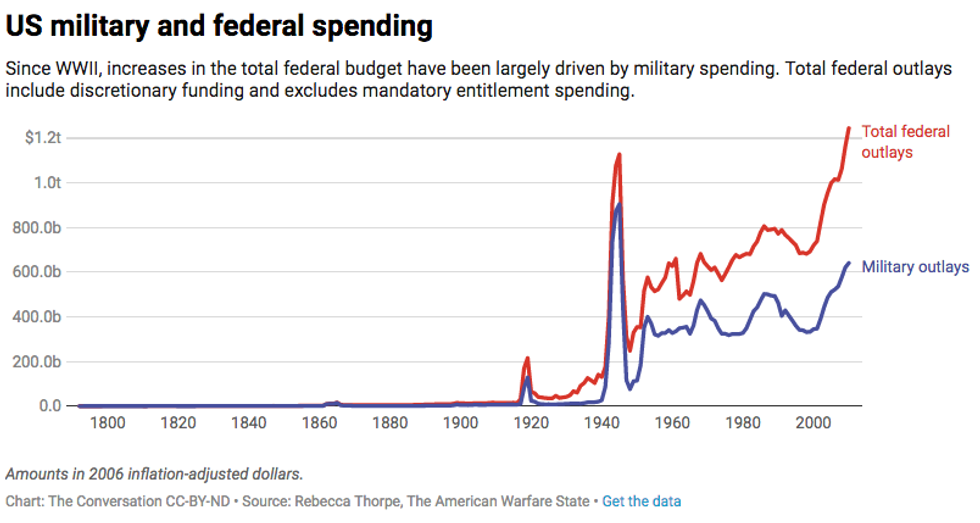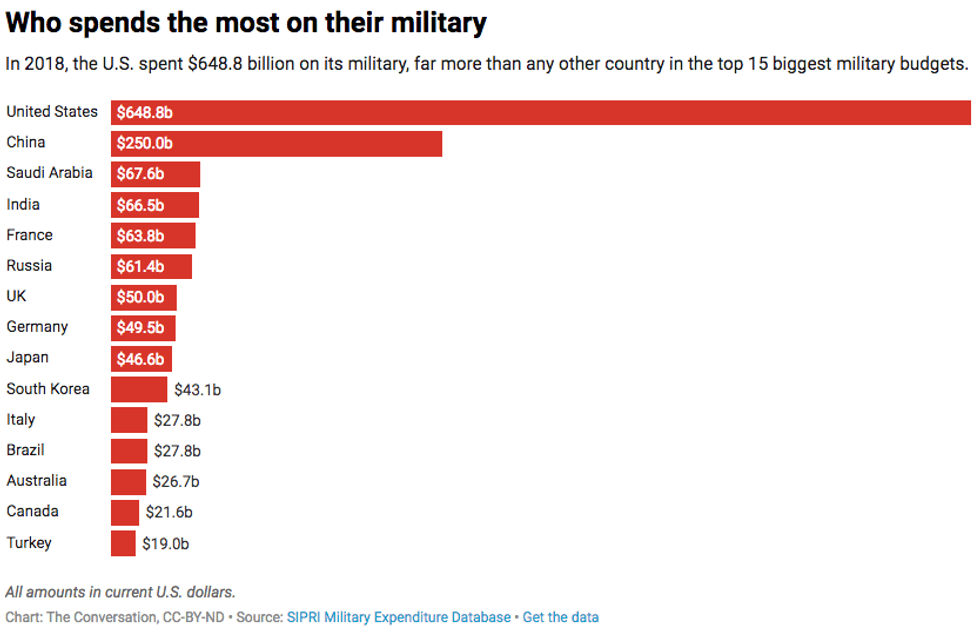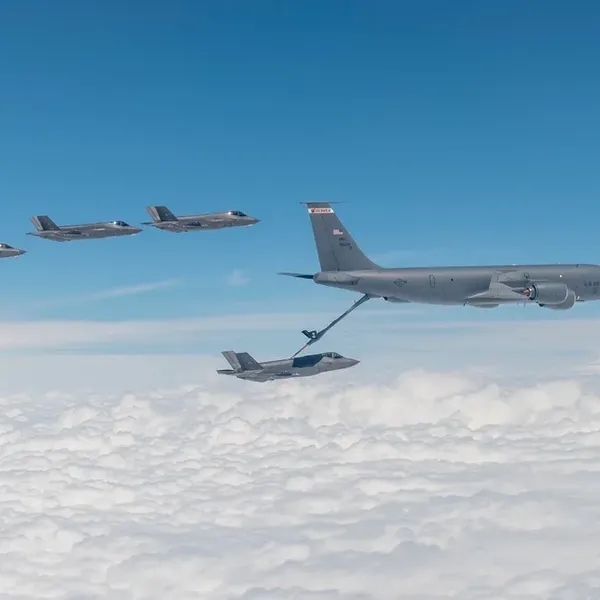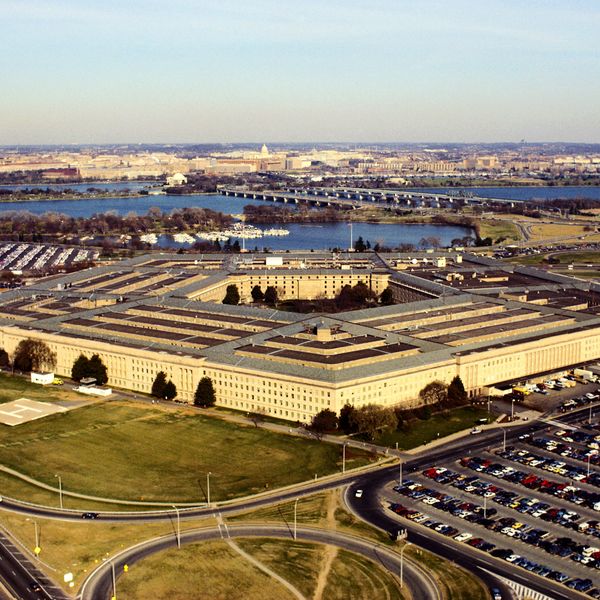
While the U.S. has the most powerful military machine in history, it is also incomparably the most expensive - and members of Congress work aggressively to maintain it. (Photo: Scott Nelson/Getty Images)
One Budget Line Congress Can Agree On: Spending Billions on the US Military
Americans are increasingly insulated and isolated from the political, economic and human costs of warfare.
The two-year budget deal signed into law in July marks a rare bipartisan agreement.
The deal adds US$320 billion over current spending levels spread across defense and non-defense programs, averting the threat of debt default until after the 2020 election and reducing the threat of another government shutdown. To forestall imminent budget crisis, party leaders agreed to pile on to the nation's $1 trillion deficit by adding another $1.7 trillion to the national debt over the next decade.
Despite stark partisan divisions on deficit spending and social programs, bipartisan support for large defense budgets is not new, nor has it been dislodged in an era marked by increasing partisan animosity.
While the U.S. has the most powerful military machine in history, it is also incomparably the most expensive - and members of Congress work aggressively to maintain it.
The roots of defense spending
As I show in my book, "The American Warfare State," bipartisan support for large defense budgets and controversial high-cost weapons systems has deep roots in World War II.
During and after the war, defense industries proliferated across the national landscape. Government investments in military technology became an important source of jobs, revenue and capital.

My research shows that, since World War II, Republican and Democratic-controlled Congresses and administrations have routinely spent more on the military than every other item in the discretionary budget added together.
The latest deal raises the baseline defense budget to $738 billion in fiscal year 2020, up from $718 billion this year. This is more than Congress spent on the military at the height of the Cold War after accounting for inflation, and nearly as much money as every other country in the world combined.

Bipartisan support
Although politicians disagree about how large defense hikes should be and how to fund them, they can rely on a baseline of support from their respective party for defense increases.
The Pentagon is the largest employer in America. Despite steady declines in the nation's manufacturing sector, U.S. weapons producers continue to generate hundreds of billions of dollars each year while providing a source of reliable employment for more than 4 million Americans.
Defense jobs are spread out across every state and a preponderance of U.S. House districts, including many suburbs, small towns and geographically remote locations that lack diverse economies.
Defense manufacturers and subcontractors for each weapons system deliberately distribute defense dollars across as many congressional districts as possible, specifically targeting defense industries in more remote, rural areas that are inordinately reliant on the defense dollars that they receive.
As a result, many members of Congress view defense spending as a bipartisan stimulus program, where the immediate benefits of continued investment - protecting local jobs - outweighs long-terms costs in strategic trade-offs, waste or inefficiency.
For instance, consider the F-35 joint strike fighter, a stealth aircraft designed to take off like a helicopter, fly at supersonic speeds and manage aircraft-carrier landings. The costs amount to $100 million per plane and $1.5 trillion over life of the program. The F-35 has experienced chronic delays, cost overruns and mechanical problems since its inception.
Yet, F-35 unites unlikely allies from conservative Kay Granger (R-Texas) - chairwoman of the defense appropriations subcommittee representing Fort Worth, where a sprawling Lockheed Martin plant assembles the plane and the program is viewed as vital to the economy --- to self-declared socialist Bernie Sanders (I-Vt.) who fought to get the F-35 unit assigned to the Air National Guard in Burlington.
Although the plane has only been used in combat one time, Congress voted along bipartisan lines to spend an additional $10.7 billion for 77 more planes in the FY2020 budget.
During the second Democratic presidential primary debates in late July, the candidates uniformly indicted the Republicans on tax cuts, deficit spending and lack of action on pressing security needs like cyberattacks, election security and the climate crisis. Yet, no candidate mentioned defense cuts or reduced funding for high-tech programs, like the F-35, as a potential source of revenue or strategic necessity.
Americans' exposure to war
While large numbers of Americans support an aggressive American military posture, a diminishing percentage of Americans are actually involved with the military.
Americans are increasingly insulated and isolated from the political, economic and human costs of warfare. Selective deferments in Vietnam and elimination of the military draft in 1973 transformed military service from a widely shared civic duty to a voluntary option, which severed most Americans' connections to the military. Increasing reliance on private military and security contractors in U.S. war zones also reduce the number of volunteers needed to fight wars overseas. Finally, greater use of unmanned technology, like drones, makes it possible to engage in overseas conflicts without placing American lives at risk.
As a result, fewer Americans today serve in the armed forces and fight or die in U.S. wars than any other period in the nation's history. At the same time, the burden of serving multiple overseas deployments falls disproportionately on the poor, less educated and communities of color.
Meanwhile, Americans no longer pay the full financial costs of maintaining military establishments and fighting major wars. Instead, as budgets increasingly roll into deficit spending, policymakers can promote large defense budgets and wage perpetual war without raising taxes or demanding financial sacrifices.
The importance of defense spending for core Republican and Democratic constituencies and increasing public insulation from war make it difficult to have a national conversation about downsizing or reprioritizing defense budgets. As the latest budget deal reflects, this rare point of partisan agreement is increasingly perilous to a nation facing unchecked budget deficits and new geopolitical realities.
An Urgent Message From Our Co-Founder
Dear Common Dreams reader, The U.S. is on a fast track to authoritarianism like nothing I've ever seen. Meanwhile, corporate news outlets are utterly capitulating to Trump, twisting their coverage to avoid drawing his ire while lining up to stuff cash in his pockets. That's why I believe that Common Dreams is doing the best and most consequential reporting that we've ever done. Our small but mighty team is a progressive reporting powerhouse, covering the news every day that the corporate media never will. Our mission has always been simple: To inform. To inspire. And to ignite change for the common good. Now here's the key piece that I want all our readers to understand: None of this would be possible without your financial support. That's not just some fundraising cliche. It's the absolute and literal truth. We don't accept corporate advertising and never will. We don't have a paywall because we don't think people should be blocked from critical news based on their ability to pay. Everything we do is funded by the donations of readers like you. Will you donate now to help power the nonprofit, independent reporting of Common Dreams? Thank you for being a vital member of our community. Together, we can keep independent journalism alive when it’s needed most. - Craig Brown, Co-founder |
The two-year budget deal signed into law in July marks a rare bipartisan agreement.
The deal adds US$320 billion over current spending levels spread across defense and non-defense programs, averting the threat of debt default until after the 2020 election and reducing the threat of another government shutdown. To forestall imminent budget crisis, party leaders agreed to pile on to the nation's $1 trillion deficit by adding another $1.7 trillion to the national debt over the next decade.
Despite stark partisan divisions on deficit spending and social programs, bipartisan support for large defense budgets is not new, nor has it been dislodged in an era marked by increasing partisan animosity.
While the U.S. has the most powerful military machine in history, it is also incomparably the most expensive - and members of Congress work aggressively to maintain it.
The roots of defense spending
As I show in my book, "The American Warfare State," bipartisan support for large defense budgets and controversial high-cost weapons systems has deep roots in World War II.
During and after the war, defense industries proliferated across the national landscape. Government investments in military technology became an important source of jobs, revenue and capital.

My research shows that, since World War II, Republican and Democratic-controlled Congresses and administrations have routinely spent more on the military than every other item in the discretionary budget added together.
The latest deal raises the baseline defense budget to $738 billion in fiscal year 2020, up from $718 billion this year. This is more than Congress spent on the military at the height of the Cold War after accounting for inflation, and nearly as much money as every other country in the world combined.

Bipartisan support
Although politicians disagree about how large defense hikes should be and how to fund them, they can rely on a baseline of support from their respective party for defense increases.
The Pentagon is the largest employer in America. Despite steady declines in the nation's manufacturing sector, U.S. weapons producers continue to generate hundreds of billions of dollars each year while providing a source of reliable employment for more than 4 million Americans.
Defense jobs are spread out across every state and a preponderance of U.S. House districts, including many suburbs, small towns and geographically remote locations that lack diverse economies.
Defense manufacturers and subcontractors for each weapons system deliberately distribute defense dollars across as many congressional districts as possible, specifically targeting defense industries in more remote, rural areas that are inordinately reliant on the defense dollars that they receive.
As a result, many members of Congress view defense spending as a bipartisan stimulus program, where the immediate benefits of continued investment - protecting local jobs - outweighs long-terms costs in strategic trade-offs, waste or inefficiency.
For instance, consider the F-35 joint strike fighter, a stealth aircraft designed to take off like a helicopter, fly at supersonic speeds and manage aircraft-carrier landings. The costs amount to $100 million per plane and $1.5 trillion over life of the program. The F-35 has experienced chronic delays, cost overruns and mechanical problems since its inception.
Yet, F-35 unites unlikely allies from conservative Kay Granger (R-Texas) - chairwoman of the defense appropriations subcommittee representing Fort Worth, where a sprawling Lockheed Martin plant assembles the plane and the program is viewed as vital to the economy --- to self-declared socialist Bernie Sanders (I-Vt.) who fought to get the F-35 unit assigned to the Air National Guard in Burlington.
Although the plane has only been used in combat one time, Congress voted along bipartisan lines to spend an additional $10.7 billion for 77 more planes in the FY2020 budget.
During the second Democratic presidential primary debates in late July, the candidates uniformly indicted the Republicans on tax cuts, deficit spending and lack of action on pressing security needs like cyberattacks, election security and the climate crisis. Yet, no candidate mentioned defense cuts or reduced funding for high-tech programs, like the F-35, as a potential source of revenue or strategic necessity.
Americans' exposure to war
While large numbers of Americans support an aggressive American military posture, a diminishing percentage of Americans are actually involved with the military.
Americans are increasingly insulated and isolated from the political, economic and human costs of warfare. Selective deferments in Vietnam and elimination of the military draft in 1973 transformed military service from a widely shared civic duty to a voluntary option, which severed most Americans' connections to the military. Increasing reliance on private military and security contractors in U.S. war zones also reduce the number of volunteers needed to fight wars overseas. Finally, greater use of unmanned technology, like drones, makes it possible to engage in overseas conflicts without placing American lives at risk.
As a result, fewer Americans today serve in the armed forces and fight or die in U.S. wars than any other period in the nation's history. At the same time, the burden of serving multiple overseas deployments falls disproportionately on the poor, less educated and communities of color.
Meanwhile, Americans no longer pay the full financial costs of maintaining military establishments and fighting major wars. Instead, as budgets increasingly roll into deficit spending, policymakers can promote large defense budgets and wage perpetual war without raising taxes or demanding financial sacrifices.
The importance of defense spending for core Republican and Democratic constituencies and increasing public insulation from war make it difficult to have a national conversation about downsizing or reprioritizing defense budgets. As the latest budget deal reflects, this rare point of partisan agreement is increasingly perilous to a nation facing unchecked budget deficits and new geopolitical realities.
The two-year budget deal signed into law in July marks a rare bipartisan agreement.
The deal adds US$320 billion over current spending levels spread across defense and non-defense programs, averting the threat of debt default until after the 2020 election and reducing the threat of another government shutdown. To forestall imminent budget crisis, party leaders agreed to pile on to the nation's $1 trillion deficit by adding another $1.7 trillion to the national debt over the next decade.
Despite stark partisan divisions on deficit spending and social programs, bipartisan support for large defense budgets is not new, nor has it been dislodged in an era marked by increasing partisan animosity.
While the U.S. has the most powerful military machine in history, it is also incomparably the most expensive - and members of Congress work aggressively to maintain it.
The roots of defense spending
As I show in my book, "The American Warfare State," bipartisan support for large defense budgets and controversial high-cost weapons systems has deep roots in World War II.
During and after the war, defense industries proliferated across the national landscape. Government investments in military technology became an important source of jobs, revenue and capital.

My research shows that, since World War II, Republican and Democratic-controlled Congresses and administrations have routinely spent more on the military than every other item in the discretionary budget added together.
The latest deal raises the baseline defense budget to $738 billion in fiscal year 2020, up from $718 billion this year. This is more than Congress spent on the military at the height of the Cold War after accounting for inflation, and nearly as much money as every other country in the world combined.

Bipartisan support
Although politicians disagree about how large defense hikes should be and how to fund them, they can rely on a baseline of support from their respective party for defense increases.
The Pentagon is the largest employer in America. Despite steady declines in the nation's manufacturing sector, U.S. weapons producers continue to generate hundreds of billions of dollars each year while providing a source of reliable employment for more than 4 million Americans.
Defense jobs are spread out across every state and a preponderance of U.S. House districts, including many suburbs, small towns and geographically remote locations that lack diverse economies.
Defense manufacturers and subcontractors for each weapons system deliberately distribute defense dollars across as many congressional districts as possible, specifically targeting defense industries in more remote, rural areas that are inordinately reliant on the defense dollars that they receive.
As a result, many members of Congress view defense spending as a bipartisan stimulus program, where the immediate benefits of continued investment - protecting local jobs - outweighs long-terms costs in strategic trade-offs, waste or inefficiency.
For instance, consider the F-35 joint strike fighter, a stealth aircraft designed to take off like a helicopter, fly at supersonic speeds and manage aircraft-carrier landings. The costs amount to $100 million per plane and $1.5 trillion over life of the program. The F-35 has experienced chronic delays, cost overruns and mechanical problems since its inception.
Yet, F-35 unites unlikely allies from conservative Kay Granger (R-Texas) - chairwoman of the defense appropriations subcommittee representing Fort Worth, where a sprawling Lockheed Martin plant assembles the plane and the program is viewed as vital to the economy --- to self-declared socialist Bernie Sanders (I-Vt.) who fought to get the F-35 unit assigned to the Air National Guard in Burlington.
Although the plane has only been used in combat one time, Congress voted along bipartisan lines to spend an additional $10.7 billion for 77 more planes in the FY2020 budget.
During the second Democratic presidential primary debates in late July, the candidates uniformly indicted the Republicans on tax cuts, deficit spending and lack of action on pressing security needs like cyberattacks, election security and the climate crisis. Yet, no candidate mentioned defense cuts or reduced funding for high-tech programs, like the F-35, as a potential source of revenue or strategic necessity.
Americans' exposure to war
While large numbers of Americans support an aggressive American military posture, a diminishing percentage of Americans are actually involved with the military.
Americans are increasingly insulated and isolated from the political, economic and human costs of warfare. Selective deferments in Vietnam and elimination of the military draft in 1973 transformed military service from a widely shared civic duty to a voluntary option, which severed most Americans' connections to the military. Increasing reliance on private military and security contractors in U.S. war zones also reduce the number of volunteers needed to fight wars overseas. Finally, greater use of unmanned technology, like drones, makes it possible to engage in overseas conflicts without placing American lives at risk.
As a result, fewer Americans today serve in the armed forces and fight or die in U.S. wars than any other period in the nation's history. At the same time, the burden of serving multiple overseas deployments falls disproportionately on the poor, less educated and communities of color.
Meanwhile, Americans no longer pay the full financial costs of maintaining military establishments and fighting major wars. Instead, as budgets increasingly roll into deficit spending, policymakers can promote large defense budgets and wage perpetual war without raising taxes or demanding financial sacrifices.
The importance of defense spending for core Republican and Democratic constituencies and increasing public insulation from war make it difficult to have a national conversation about downsizing or reprioritizing defense budgets. As the latest budget deal reflects, this rare point of partisan agreement is increasingly perilous to a nation facing unchecked budget deficits and new geopolitical realities.

